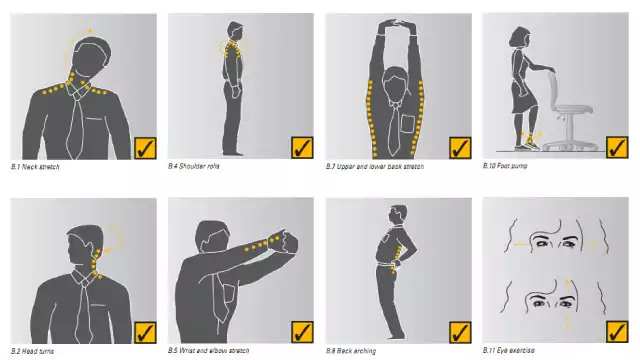The human body was not designed to constantly sit at a desk, and the nine-to-five grind can have many negative effects. Inactivity is the major culprit; even the most ergonomically designed office will leave the body wanting a quick stretch or a bit of movement. Here are some simple activities to help the body exist peacefully in the workplace.
Invigorate Your Legs
An ineffective chair and or sitting position can cut off circulation to a persons legs, weakening them. This can be easily combated by standing up or a quick stroll at least once every 30 minutes—and can coincide with filling up your water bottle or a trip to the bathroom. Another easy addition is to do some knee-bends; the change in weight and position of the body will stimulate blood flow and often release tightness in the hips.
If you don’t want to do a mini-yoga routine at your desk, you can keep a small bag of treats in the back of a low drawer in your desk. Instead of leaning over in your chair to get at the treats, stand up and do a knee-bend down to the level of the drawer instead.
Relieve Your Back
It can be difficult to find the perfect office chair—supportive for the back, and comfortable for the seat, while not luxurious enough to detract from that very important to-do list—and when 40 hours a week are spent in the wrong chair, the back guaranteed to suffer. The best thing to do to prevent back pain is to keep it from staying in one place long enough to create tension.
Every 15-30 minutes, take a 30 second break to allow your back to move. Pinch your shoulders back to allow the front of your ribcage to open and your upper back to lift, and then clasp your hands together, tuck your chin forward, and draw your hands away from your torso, allowing your upper back to feel a stretch between the shoulder blades. Then, allow your lower back to relax by scooting your chair away from your desk, and resting your head on your hands, flat on the desk. This will take the weight of the upper torso off of the lumbar spine and give it a few moments of relaxation before continuing with the day.
Relax Your Neck
One of the most common muscle strains to happen in the office is straining a muscle in the neck, often caused by a monitor or document at the wrong height or angle. To prevent a muscle strain, allow yourself short breaks to look from side to side, up and down, and to roll your head in a slow, deliberate circle. Each time you change direction, you should hold the new position for two seconds and breathe before continuing. Also, massage the muscles and tendons from the nape of your neck all the way down to the top of your shoulder blades to help release any pent-up tension.
The Whole Body
The best thing to keep in mind is how much the body likes to move and experience the world—stagnation will lead the body to tense or strain just as often as overexertion will. When there is an opportunity to change location or venue without losing productivity, take it. You will find your body feeling better if you give it small allowances of time to be free of your desk chair instead of waiting until you feel the painful effects before you take action.
